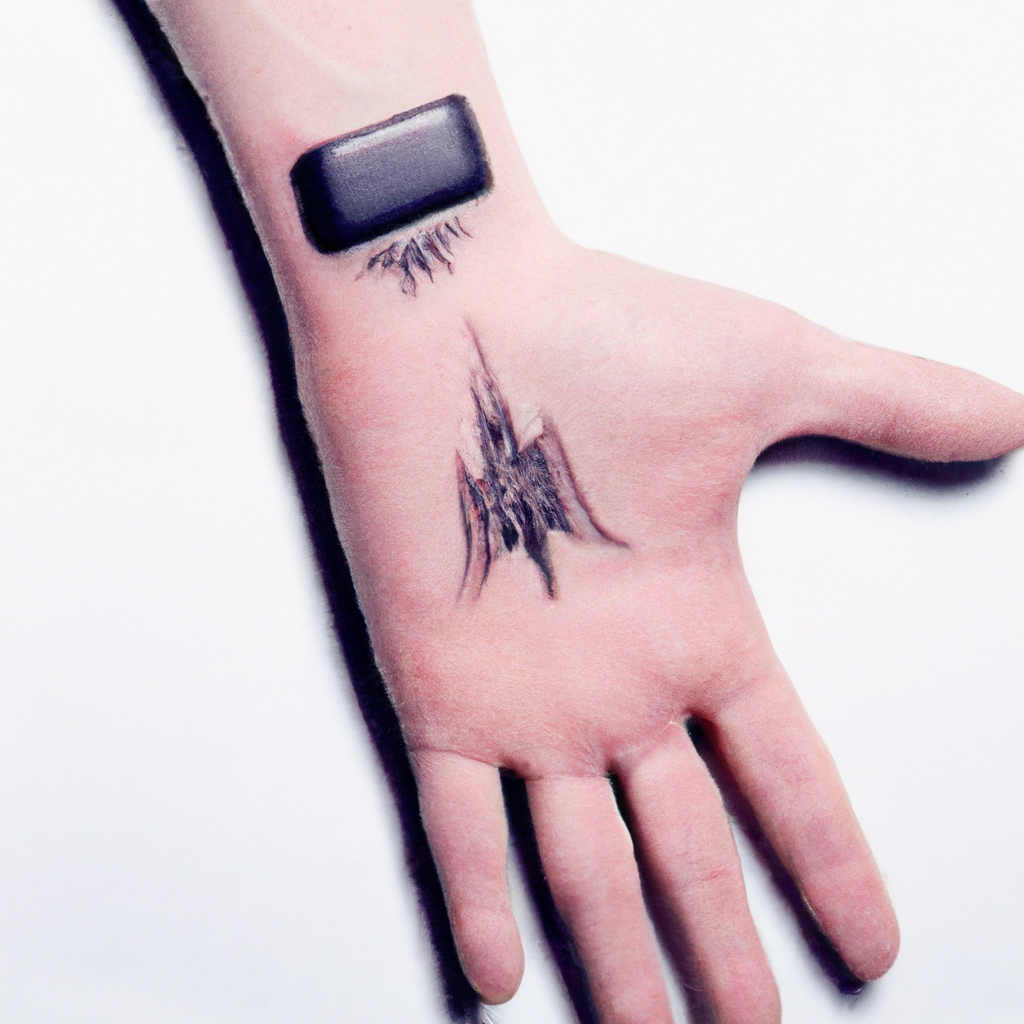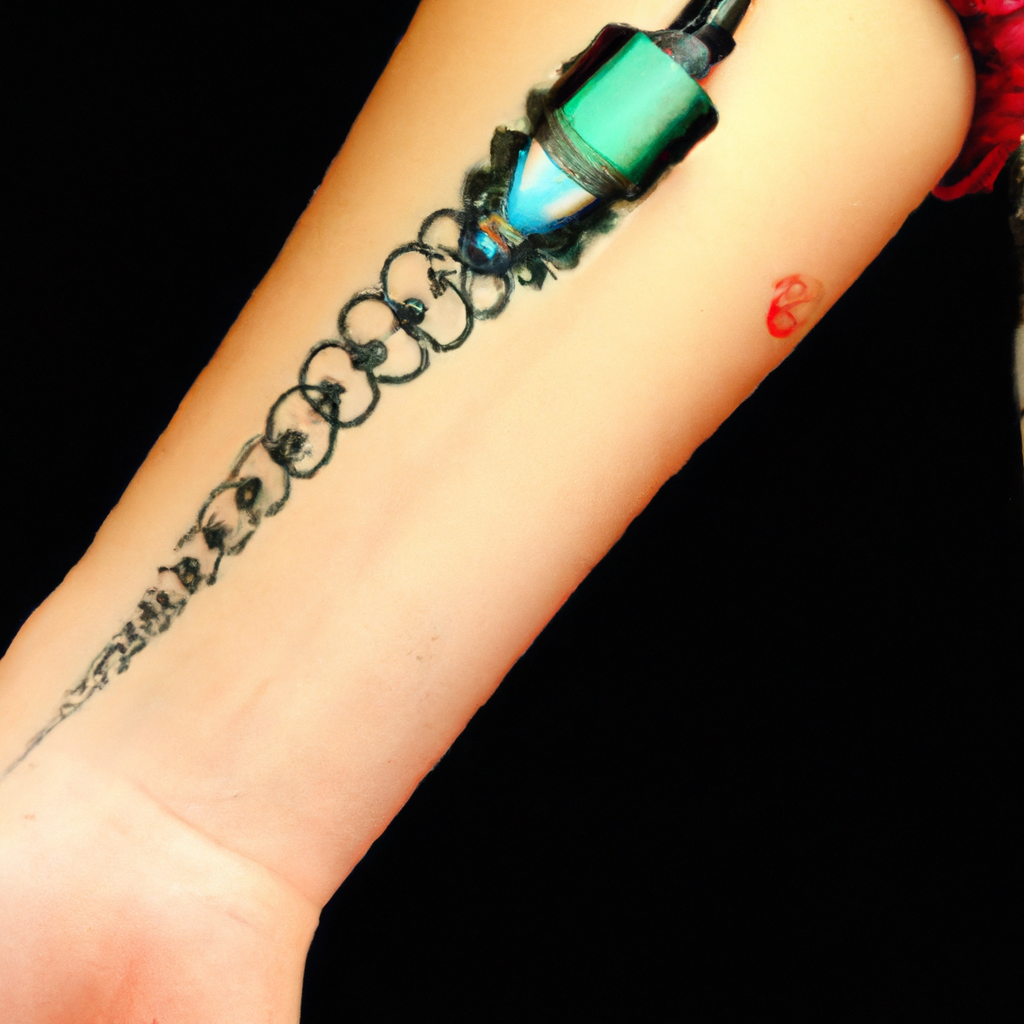Imagine a world where your tattoos not only showcase your unique style but also serve a purpose beyond aesthetics. smart tattoos, the latest trend in the world of body art, are revolutionizing the way we think about tattoos. Combining stunning artistic designs with cutting-edge technology, these innovative tattoos can track your health, store important data, and even communicate with other devices. With the ability to seamlessly merge art and functionality on human skin, Smart Tattoos are paving the way for a new era of personalized and intelligent body modifications.

Understanding Smart Tattoos
Definition of Smart Tattoos
Smart tattoos are a form of body modification that incorporates advanced technology and electronics into the skin, providing both aesthetic and functional benefits. Unlike traditional tattoos, which are purely decorative, smart tattoos have the ability to interact with external devices and perform various tasks, such as health monitoring, navigation, and wireless payments.
Historical Background of Tattoos
Tattoos have been a part of human culture for thousands of years, with evidence of their existence dating back to ancient civilizations. From tribal markings to religious symbols, tattoos have served as a form of self-expression and cultural identity. The popularity of tattoos has only grown over the years, with individuals using them as a way to commemorate milestones, express their beliefs, or simply enhance their appearance.
Introduction to Smart Technology on Skin
With advancements in technology, the concept of smart technology has now made its way onto human skin. Smart tattoos merge the art of tattooing with the functionality of electronic devices, creating a unique and innovative form of body modification. These tattoos can be designed to respond to stimuli, communicate wirelessly with external devices, and provide real-time information, making them a fascinating addition to the world of wearable technology.
Types of Smart Tattoos
Biometric Tattoos
Biometric tattoos are designed to monitor and track various physiological parameters of the wearer. By using biosensors embedded within the tattoo, these tattoos can measure heart rate, blood pressure, body temperature, and other vital health indicators. This data can then be transmitted wirelessly to a smartphone app or a healthcare professional, providing valuable insights into the wearer’s overall well-being.
NFC Smart Tattoos
NFC (Near Field Communication) smart tattoos enable individuals to interact with devices and make contactless payments. These tattoos contain an embedded NFC chip that can be scanned by compatible devices, allowing for seamless communication and transactions. With NFC smart tattoos, you can simply wave your hand over a payment terminal to make a purchase, providing convenience and efficiency in daily life.
LED Tattoos
LED tattoos incorporate flexible LED lights into the design, creating intricate patterns and vibrant displays on the skin. These tattoos can be programmed to change colors, flash, or even display simple animations. LED tattoos are a perfect way to add a unique visual element to your body art, making a statement and capturing attention in any setting.
Solar Tattoos
Solar tattoos utilize photosensitive ink or solar cells to harness solar energy and convert it into electrical power. These tattoos can generate electricity to power small devices or recharge batteries. With solar tattoos, you can harness the power of the sun and use it to charge your smartphone, wearable devices, or other electronic gadgets on the go.
Color-changing Tattoos Based on Health Indicators
Color-changing smart tattoos are designed to respond to changes in the wearer’s health indicators. By using bioresponsive inks or pigments, these tattoos can change color or pattern based on fluctuations in body temperature, blood sugar levels, or other health parameters. This provides a visual cue, allowing individuals and healthcare professionals to easily monitor changes in health status.
How Smart Tattoos Work
The Merging of Art and Technology
The concept of smart tattoos relies on the seamless integration of art and technology. Tattoo artists work closely with technologists to incorporate electronic components and advanced materials into the design, ensuring that the final product is both visually appealing and functional. This collaboration between artists and technologists has led to the development of innovative techniques and materials that enable smart tattoos to function effectively on the skin.
Biocompatible Ink
Smart tattoos require the use of biocompatible ink, which is safe to be injected into the skin and does not cause any adverse reactions. This ink is specifically formulated to withstand the constant movement and stretching of the skin without fading or losing its functionality. The ink must also be capable of conducting electricity or responding to external stimuli, depending on the type of smart tattoo being created.
Circuit Designing
Smart tattoos often incorporate flexible circuits or microelectronics that are embedded within the design. These circuits enable the tattoo to perform its intended function, whether it’s monitoring health parameters, communicating with external devices, or generating electrical power. Circuit designers work closely with tattoo artists to ensure that the circuits are seamlessly integrated into the design, creating a visually appealing and functional outcome.
Interaction with Smartphone Apps
Many smart tattoos are designed to interact with smartphone apps, allowing wearers to access real-time data, customize settings, or perform various tasks. These apps provide a user-friendly interface that enables individuals to fully utilize the capabilities of their smart tattoos. From tracking health data to managing payments, smartphone apps play a crucial role in enhancing the functionality and usability of smart tattoos.
Artistic Aspects of Smart Tattoos
Expressing Individuality through Design
Smart tattoos offer a unique opportunity for individuals to express their individuality and personal style. These tattoos can be fully customized and personalized, allowing wearers to create a design that reflects their personality, interests, or values. Whether it’s a biometric tattoo that incorporates a heartbeat waveform or an LED tattoo that displays a favorite quote, smart tattoos enable individuals to turn their bodies into canvases of self-expression.
Adopting Traditional Tattoo Themes and Designs
While smart tattoos introduce a new level of functionality, they also embrace traditional tattoo themes and designs. Many individuals choose to incorporate classic tattoo elements, such as anchors, roses, or dragons, into their smart tattoo designs. This fusion of traditional and modern elements creates a seamless blend of aesthetics and technology, preserving the essence of tattoo culture while embracing the advancements of the digital age.
Uniqueness and Creativity in Smart Tattoo Designs
Smart tattoos push the boundaries of creativity and open up endless possibilities for innovative designs. Artists can experiment with unique patterns, textures, and color palettes to create visually stunning tattoos that captivate the eye. The integration of technology allows for dynamic and interactive elements, adding a new dimension to the artistic possibilities of tattooing. From pulsating LED patterns to color-changing pigments, smart tattoos redefine what it means to be a work of art.

Functional Attributes of Smart Tattoos
Health Monitoring Attributes
One of the key functional attributes of smart tattoos is their ability to monitor various health parameters. Biometric tattoos, for example, can continuously track heart rate, blood pressure, and body temperature, providing wearers with real-time insights into their overall health. This data can be invaluable for individuals with chronic conditions, athletes monitoring performance, or anyone seeking to maintain a healthy lifestyle.
Navigation Functionalities
Smart tattoos can also incorporate navigation functionalities that help individuals find their way in unfamiliar places. By using GPS technology, these tattoos can provide visual or haptic feedback to guide the wearer to their desired destination. This can be particularly useful in situations where traditional navigation systems are impractical or unavailable, making smart tattoos a reliable and convenient alternative.
Wireless Payment Capabilities
Another functional attribute of smart tattoos is their ability to facilitate wireless payments. NFC tattoos, equipped with near field communication technology, can be scanned by compatible devices, allowing wearers to make contactless payments with a simple wave of their hand. This feature eliminates the need for physical wallets or payment cards, making transactions quick, secure, and hassle-free.
Application of Smart Tattoos in Healthcare
Disease Monitoring
Smart tattoos have the potential to revolutionize disease monitoring by providing real-time and non-invasive data collection. Individuals with chronic conditions, such as diabetes or cardiovascular disease, can benefit from biometric tattoos that continuously monitor their vital signs and alert them to any significant changes. This early detection and intervention can help individuals manage their conditions more effectively and improve overall health outcomes.
Medication Reminders
Smart tattoos can also serve as medication reminders, ensuring individuals adhere to their prescribed treatment plans. LED tattoos, for example, can be programmed to display visual cues or reminders at specific times. These reminders can be particularly beneficial for individuals with memory or cognitive impairments, helping them stay on track with their medication routines and enhancing medication adherence.
Continuous Health Tracking
In addition to disease monitoring and medication reminders, smart tattoos enable continuous health tracking. By collecting and analyzing data over time, these tattoos can provide wearers with valuable insights into their health trends and patterns. This information can help individuals make informed decisions about their lifestyle, identify potential health risks, and take proactive measures to prevent or manage health conditions.
Patient Identification in Care Situations
Smart tattoos can also play a vital role in healthcare settings by facilitating patient identification. NFC tattoos, for example, can be used to store important medical information, such as allergies, blood type, or emergency contact details. This information can be easily accessed by healthcare professionals in emergency situations, ensuring accurate and efficient care.

The Fashion Aspect of Smart Tattoos
Tattoo Trends in the Fashion Industry
Tattoos have become increasingly popular in the fashion industry, with many individuals incorporating them into their personal style. From models on the runway to celebrities on the red carpet, tattoos have become a fashion statement and an integral part of many individuals’ overall look. Smart tattoos take this trend to the next level by combining fashion and functionality, allowing individuals to showcase their personal style while also benefiting from the features of smart technology.
Smart Tattoos as Fashion Statements
Smart tattoos offer a unique opportunity for individuals to make a fashion statement that goes beyond aesthetics alone. These tattoos can be designed to reflect personal interests, beliefs, or values, creating a powerful visual representation of individuality. Whether it’s a biometric tattoo that showcases a commitment to health and well-being or an LED tattoo that displays a favorite quote or symbol, smart tattoos enable individuals to make a bold fashion statement that captures attention and sparks conversations.
Potential Future Fashion Uses
As smart tattoo technology continues to evolve, the potential for future fashion uses expands. Imagine a smart tattoo that changes color and pattern based on mood or integrates with clothing to create a seamless visual experience. Smart tattoos could become a dynamic part of an individual’s fashion ensemble, allowing for endless creative possibilities and enhancing the overall aesthetic impact.
Potential Risks and Concerns
Privacy and Data Concerns
One of the main concerns surrounding smart tattoos is the privacy and security of personal data. As these tattoos collect and transmit sensitive health or payment information, there is a risk of unauthorized access or data breaches. Manufacturers and developers of smart tattoos must prioritize data encryption, secure communication protocols, and robust privacy policies to ensure that wearers’ information remains protected and confidential.
Health Risks
Smart tattoos require the use of specialized inks and electronic components, which may introduce potential health risks. Allergic reactions, skin irritation, or infections can occur if the materials used are not biocompatible or if proper hygiene practices are not followed during the tattooing process. It is crucial for both tattoo artists and wearers to ensure that the materials and procedures used comply with strict safety standards to minimize any adverse health effects.
Societal Acceptance and Perception
While tattoos have become more widely accepted in society, smart tattoos represent a relatively new and unfamiliar concept. There may be concerns or reservations about the integration of technology into the human body, raising questions about the blurring of boundaries between humans and machines. Educating the public about the benefits and safety of smart tattoos, as well as addressing any misconceptions or fears, will be essential in fostering acceptance and changing societal perceptions.

Future Scope of Smart Tattoos
Emerging Trends and Innovations
The field of smart tattoos is continually evolving, with new trends and innovations emerging every day. Researchers and developers are exploring advanced materials, flexible electronics, and enhanced functionalities to push the boundaries of what smart tattoos can achieve. From biodegradable inks to self-healing circuits, the future of smart tattoos promises exciting possibilities for enhanced functionality, durability, and aesthetics.
Areas of Potential Impact
Smart tattoos have the potential to impact various industries and aspects of daily life. In healthcare, they can revolutionize patient monitoring, improve disease management, and enhance personalized medicine. In the fashion industry, smart tattoos can become a must-have accessory, elevating personal style and enabling self-expression. Additionally, the integration of smart tattoos with everyday devices and systems, such as home automation or public transportation, may streamline interactions and enhance convenience.
The Role of Ongoing Research
Ongoing research and development are critical for the continued advancement of smart tattoos. Academics, scientists, and industry professionals are working together to uncover new materials, refine manufacturing processes, and explore novel applications. Through research, collaborations, and interdisciplinary efforts, the full potential of smart tattoos can be realized, ensuring their continued growth and innovation in the years to come.
Regulatory and Ethical Implications
Current Regulation of Smart Tattoos
As a relatively new technology, smart tattoos currently have limited regulations governing their design, manufacturing, and use. The responsibility for ensuring safety and compliance with existing regulations rests largely with the developers, manufacturers, and practitioners involved. However, as the popularity and adoption of smart tattoos increase, it is likely that regulatory authorities will develop specific guidelines and oversight to address potential risks and ensure consumer protection.
Ethical Debates around Body Modification and Privacy
The integration of smart technology into the human body raises important ethical considerations around body modification and privacy. Some argue that smart tattoos blur the line between the natural and the artificial, potentially eroding the concept of human identity. Others express concerns about the collection and use of personal data, highlighting the need for transparent consent and robust privacy safeguards. Striking a balance between technological advancement and ethical principles is crucial in navigating the complex landscape of smart tattoos.
The Role of Governmental Oversight
Governmental oversight plays a crucial role in shaping the future of smart tattoos. Regulatory bodies, policymakers, and legislators must work closely with industry experts and consumer advocates to establish clear guidelines and standards for the responsible development and use of smart tattoos. This includes addressing privacy concerns, promoting transparency, and ensuring the safety and welfare of individuals who choose to integrate smart technology into their bodies.
In conclusion, smart tattoos represent a fascinating collision of art, technology, and functionality on human skin. These innovative body modifications offer a range of benefits, from health monitoring and navigation to fashion statements and self-expression. While smart tattoos present potential risks and raise ethical questions, ongoing research, regulatory frameworks, and public education hold the keys to unlocking their full potential. With advancements in materials, design, and functionality, the future of smart tattoos looks incredibly promising, paving the way for a new era of personalized wearable technology.











